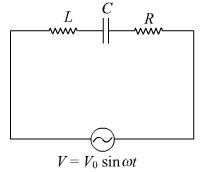(i) An a.c. source of voltage V = Vo sin ωt is connected to a series combination of L, C and R. Use the phasor diagram to obtain an expression for impedance of a circuit and the phase angle between voltage and current. Find the condition when current will be in phase with the voltage. What is the circuit in this condition called?
ii) In a series LR circuit, XL = R and the power factor of the circuit is P1. When capacitor with capacitance C, such that XL = XC is put in series, the power factor becomes P2. Calculate P1 / P2.
Voltage of the source is given by,
V = Vo sin ωt

Let current of the source be I = Io sin ωt
Maximum voltage across R is VR = Vo R, represented along OX
Maximum voltage across L = VL = IO XL, represented along OY and is 90o ahead of Io.
Maximum voltage across C = VC = Io XC, represented along OC and is lagging behind Io by 90o
Hence, reactive voltage is VL - VC, represented by OB'
the vector sum of VR, VL and VC is resultant of OA and OB', represented along OK.
OK = Vo = ![]()
i.e., Vo = ![]()
![]()
Impedance, Z = ![]()
When, XL = XC , the voltage and current are in the same phase.
In such a situation, the circuit is known as non-inductive circuit.
ii)
Given,
Power factor, P1 = R/Z
Thus, ![]()
